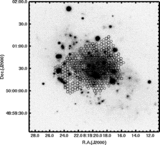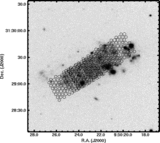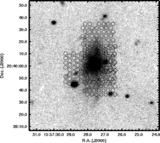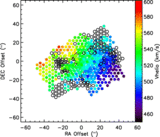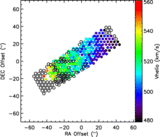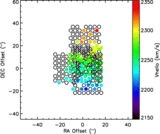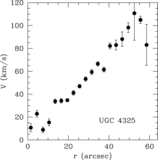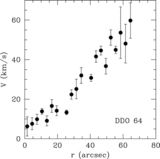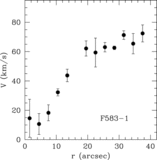Image Details
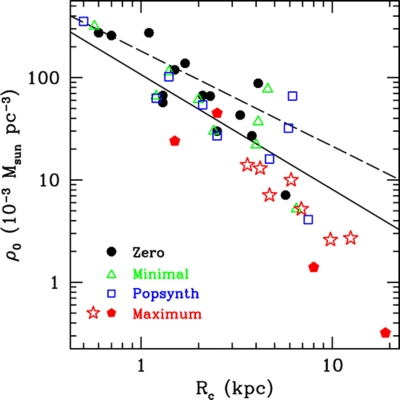
Caption: Fig. 14.
Left: Isothermal halo parameters for different assumptions about the baryons. The red pentagons indicate maximum disk fits where ﹩R_{c}﹩ is a lower limit and ﹩\rho _{0}﹩ is an upper limit. The data for NGC 959 are beyond the range of this plot and are not shown. The core radius is often ![]() 1 kpc. There is a trend toward larger ﹩R_{c}﹩ with increasing ﹩\Upsilon _{*}﹩. For comparison, the solid line represents the ﹩\rho _{0}﹩‐﹩R_{c}﹩ scaling law of Kormendy & Freeman (2004) and the dashed line represents the ﹩\rho _{0}﹩‐﹩R_{0}﹩ relation of Spano et al. (2008). Right: NFWfree halo parameters for different assumptions about the baryons. No NFW fits could be made in the maximum disk case. The solid lines show the range of c‐V200 predicted by the cosmology of Tegmark et al. (2004), whereas the dashed lines show the predictions for WMAP3 (Spergel et al. 2007). For both cosmologies, the width of the bands is ±1 σ, assuming a scatter of ﹩\sigma _{c}=0.14﹩ (Bullock et al. 2001). The data show a steeper c‐V200 relation and favor the lower concentrations/lower ﹩\sigma _{8}﹩ predicted by WMAP3.
1 kpc. There is a trend toward larger ﹩R_{c}﹩ with increasing ﹩\Upsilon _{*}﹩. For comparison, the solid line represents the ﹩\rho _{0}﹩‐﹩R_{c}﹩ scaling law of Kormendy & Freeman (2004) and the dashed line represents the ﹩\rho _{0}﹩‐﹩R_{0}﹩ relation of Spano et al. (2008). Right: NFWfree halo parameters for different assumptions about the baryons. No NFW fits could be made in the maximum disk case. The solid lines show the range of c‐V200 predicted by the cosmology of Tegmark et al. (2004), whereas the dashed lines show the predictions for WMAP3 (Spergel et al. 2007). For both cosmologies, the width of the bands is ±1 σ, assuming a scatter of ﹩\sigma _{c}=0.14﹩ (Bullock et al. 2001). The data show a steeper c‐V200 relation and favor the lower concentrations/lower ﹩\sigma _{8}﹩ predicted by WMAP3.
Copyright and Terms & Conditions
© 2008. The American Astronomical Society. All rights reserved. Printed in U.S.A.


